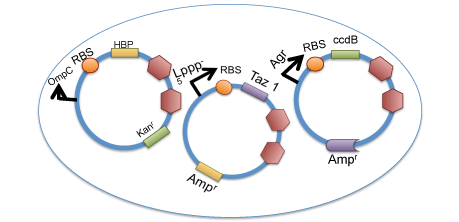Team:Brown
From 2009.igem.org
| Line 19: | Line 19: | ||
| - | + | <font> <font color="white">Every year, over fifty million people in the US suffer from allergic rhinitis, the most common type of allergy. The prevalence of allergic rhinitis and other and other inflammatory diseases has dramatically increased over the past two decades. Allergens, such as pollen, dust, and dander, cause the excessive release of histamine in the nasal cavity, resulting in nasal congestion, itching, burning, sneezing, and overall discomfort. Current treatments include over-the-counter antihistamines, however, side effects of these drugs include drowsiness, restlessness, and poor concentration. For patients suffering from chronic allergies and inflammation, there is a great need for an alternative strategy for combating allergic symptoms without causing significant side effects. | |
| - | + | ||
| + | <center>[[Image:3plasmids.gif]]</center> | ||
The 2009 Brown University iGEM team worked to treat allergic rhinitis by engineering Staphylococcus epidermidis, a microbe endogenous to the human nasal flora, to secrete a recombinant histamine-binding protein in response to the elevated histamine concentrations of an allergic response. The engineered strain of S. epidermidis will function as a self-regulating drug factory in the nose, providing relief, without any negative side effects. | The 2009 Brown University iGEM team worked to treat allergic rhinitis by engineering Staphylococcus epidermidis, a microbe endogenous to the human nasal flora, to secrete a recombinant histamine-binding protein in response to the elevated histamine concentrations of an allergic response. The engineered strain of S. epidermidis will function as a self-regulating drug factory in the nose, providing relief, without any negative side effects. | ||
| - | |||
| - | |||
| - | |||
Revision as of 14:07, 15 October 2009

| Home | The Team | The Project | Parts Submitted to the Registry | Notebook | Links | Gallery |
|---|
Every year, over fifty million people in the US suffer from allergic rhinitis, the most common type of allergy. The prevalence of allergic rhinitis and other and other inflammatory diseases has dramatically increased over the past two decades. Allergens, such as pollen, dust, and dander, cause the excessive release of histamine in the nasal cavity, resulting in nasal congestion, itching, burning, sneezing, and overall discomfort. Current treatments include over-the-counter antihistamines, however, side effects of these drugs include drowsiness, restlessness, and poor concentration. For patients suffering from chronic allergies and inflammation, there is a great need for an alternative strategy for combating allergic symptoms without causing significant side effects.

The 2009 Brown University iGEM team worked to treat allergic rhinitis by engineering Staphylococcus epidermidis, a microbe endogenous to the human nasal flora, to secrete a recombinant histamine-binding protein in response to the elevated histamine concentrations of an allergic response. The engineered strain of S. epidermidis will function as a self-regulating drug factory in the nose, providing relief, without any negative side effects.
 "
"